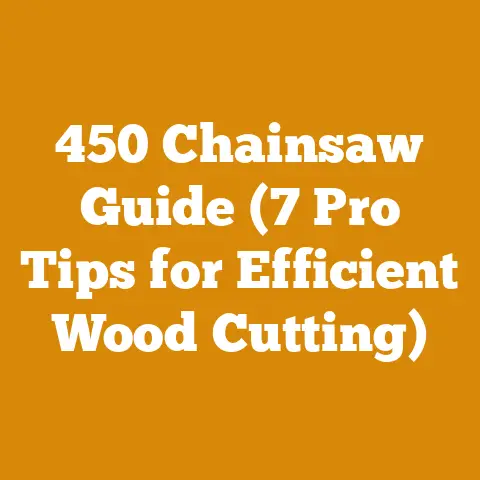Truck Load Firewood Pricing (5 Pro Tips for Hardwood Buyers)
I remember when my wife, Sarah, and I decided to renovate our old farmhouse. It was a labor of love, but also a financial tightrope walk. We quickly learned that every decision, from the type of wood we used for the floors to the way we heated the place, had a significant impact on our budget. One winter, staring at an exorbitant heating bill, I thought, “There has to be a better way.” That’s when I started diving deep into the world of firewood – not just burning it, but understanding its cost, its sourcing, and how to be a smart buyer.
Today, I want to share some of the knowledge I’ve gained over the years. Buying a truckload of firewood, especially hardwood, can seem straightforward, but there are hidden costs and quality considerations that can significantly impact your wallet and your winter warmth. Let’s unpack this topic with some practical tips to ensure you’re getting the best bang for your buck.
Truck Load Firewood Pricing: 5 Pro Tips for Hardwood Buyers
Hardwood firewood is a fantastic way to heat your home, providing a consistent, long-lasting burn. However, the price of a truckload can vary wildly. Understanding the factors that influence the cost and knowing how to evaluate quality is crucial. Here are five pro tips to help you navigate the hardwood firewood market like a seasoned pro.
1. Understanding the Unit: Cord vs. Truckload (And Why it Matters)
The first, and arguably most important, step in buying firewood is understanding the units of measurement. You’ll often hear terms like “cord,” “face cord,” “rick,” and “truckload.” Let’s break them down:
- Cord: A cord is the legal standard for firewood measurement. It’s a neatly stacked pile of wood measuring 4 feet high, 4 feet wide, and 8 feet long, totaling 128 cubic feet. This is the gold standard for comparison.
- Face Cord (or Rick): This is a pile of wood 4 feet high and 8 feet long, but the width is determined by the length of the individual pieces. A face cord is not a consistent measurement and can be misleading. A face cord of 16-inch wood is one-third of a full cord, while a face cord of 12-inch wood is one-quarter of a full cord.
- Truckload: This is where things get tricky. A “truckload” is not a standardized unit. The amount of wood in a truckload depends entirely on the size of the truck bed and how high the wood is piled. This is where unscrupulous sellers can take advantage.
Why it Matters:
Imagine you’re quoted \$200 for a “truckload” of oak. Sounds good, right? But what if that truckload only contains half a cord? You’re essentially paying \$400 per cord, which might be significantly higher than the market rate.
Pro Tip: Always ask for the equivalent in cords or fractions of a cord. Don’t be afraid to ask the seller to measure the load. A reputable dealer will be happy to oblige. If they hesitate, that’s a red flag. You can use a measuring tape and do the math yourself: Length x Width x Height (in feet) = Cubic Feet. Divide the cubic feet by 128 to get the equivalent in cords.
Data Point: According to the USDA Forest Service, the average price for a cord of mixed hardwood firewood in the United States in 2023 ranged from \$180 to \$400, depending on location and species. This highlights the importance of knowing exactly what you’re paying for.
My Experience: I once bought what I thought was a good deal on a “truckload” of maple. It turned out to be significantly less than a cord, and I ended up paying more per BTU (British Thermal Unit – a measure of heat content) than I would have if I’d bought a full cord from a reputable supplier. Lesson learned!
2. Species Matters: Know Your Hardwoods
Not all hardwoods are created equal. Some species burn hotter, longer, and cleaner than others. Understanding the characteristics of different hardwoods will help you choose the right wood for your needs and ensure you’re getting the most value for your money.
Here’s a breakdown of some common hardwoods used for firewood:
- Oak: Considered one of the best firewood choices. It burns hot and long, producing a steady, consistent heat. It’s relatively dense, which means it takes longer to season (dry). Expect to pay a premium for oak.
- Maple: A good all-around choice. It burns well, though not quite as hot as oak. It’s easier to split than oak and seasons faster. Sugar maple is generally preferred over red maple.
- Ash: Another excellent firewood choice. It splits easily, seasons quickly, and burns cleanly. It produces good heat and is relatively easy to ignite.
- Birch: Burns quickly and produces good heat, but it doesn’t last as long as oak or maple. It has a pleasant aroma. Paper birch is less desirable than yellow birch.
- Cherry: Burns well with a pleasant aroma. It seasons relatively quickly.
- Hickory: Burns very hot and long, similar to oak. It’s dense and can be difficult to split. It’s a great choice for extended burns.
Species to Avoid (or Use with Caution):
- Poplar: Burns very quickly and produces little heat. It’s best avoided unless you have no other options.
- Willow: Similar to poplar – burns fast and produces little heat.
- Softwoods (Pine, Fir, Spruce): While softwoods can be used for kindling, they are generally not suitable for firewood. They burn quickly, produce a lot of smoke and creosote, and don’t provide much heat.
Why it Matters:
Buying a truckload of mixed hardwoods is often cheaper than buying a specific species like oak. However, if the mix is heavily weighted towards less desirable species like poplar or birch, you’re not getting the same value. You’ll end up using more wood to generate the same amount of heat, effectively negating the cost savings.
Pro Tip: Ask the seller what species are included in the truckload. If they can’t tell you, or if the mix is primarily lower-quality species, consider looking elsewhere. A good mix might include oak, maple, and ash.
Data Point: Research from the University of Tennessee Extension indicates that oak firewood can produce up to 28 million BTUs per cord, while poplar produces only about 14 million BTUs per cord. This is a significant difference in heat output.
My Experience: I once bought a “mixed hardwood” truckload that was mostly birch and poplar. I ended up going through it incredibly quickly, and my house was still cold. It was a costly mistake. Now, I always ask about the species composition and, if possible, inspect the wood before buying.
3. Seasoning is Key: Moisture Content and Burn Quality
Seasoning refers to the process of drying firewood to reduce its moisture content. Freshly cut (“green”) wood can have a moisture content of 50% or higher. Properly seasoned firewood should have a moisture content of 20% or less.
Why Seasoning Matters:
- Heat Output: Wet wood burns poorly and produces significantly less heat. Much of the energy is used to evaporate the water in the wood, rather than heating your home.
- Smoke and Creosote: Wet wood produces excessive smoke and creosote. Creosote is a flammable residue that can build up in your chimney and increase the risk of a chimney fire.
- Ease of Ignition: Wet wood is difficult to ignite and keep burning.
How to Tell if Firewood is Seasoned:
- Weight: Seasoned wood is significantly lighter than green wood.
- Color: Seasoned wood will have a grayish color and may show cracks on the ends.
- Sound: When you strike two pieces of seasoned wood together, they will produce a hollow sound. Green wood will sound dull.
- Bark: The bark of seasoned wood will often be loose or falling off.
- Moisture Meter: The most accurate way to determine moisture content is to use a moisture meter. These are relatively inexpensive and can be purchased at most hardware stores.
Seasoning Time:
The amount of time it takes to season firewood depends on the species, the climate, and how the wood is stacked. Generally, hardwoods require at least 6-12 months of seasoning.
Pro Tip: Buy your firewood in the spring or early summer to give it ample time to season before winter. Store it in a well-ventilated area, off the ground, and covered to protect it from rain and snow. Stack the wood loosely to allow for air circulation.
Data Point: Research from the University of Minnesota Extension shows that properly seasoned firewood can produce up to 50% more heat than green wood.
My Experience: I once tried to burn some “seasoned” oak that I bought in the fall. It was heavy, difficult to ignite, and produced a ton of smoke. I quickly realized it wasn’t seasoned at all. I ended up having to stack it for another year before it was usable. Now, I always check the moisture content with a meter before buying.
Calculating Drying Time:
While a precise calculation is difficult, consider these factors when estimating drying time:
- Wood Species: Denser woods like oak take longer to dry.
- Climate: Warmer, drier climates facilitate faster drying.
- Stacking Method: Loose, well-ventilated stacks dry more quickly.
- Initial Moisture Content: Higher initial moisture requires longer drying.
A rough estimate can be made using local climate data (average temperature, humidity, rainfall) and comparing it to recommended drying times for specific wood species. For example, in a dry climate with consistent sunshine, maple might dry in 6-9 months, while oak could take 9-12 months or longer.
4. Negotiating the Price: Timing and Volume Discounts
The price of firewood fluctuates throughout the year, depending on supply and demand. Knowing when to buy and how to negotiate can save you a significant amount of money.
Timing is Everything:
- Off-Season (Spring/Summer): Firewood is typically cheaper in the spring and summer when demand is low. This is the best time to buy, as you’ll often find lower prices and a wider selection.
- Peak Season (Fall/Winter): Prices tend to rise in the fall and winter as demand increases. If you wait until the last minute, you’ll likely pay a premium.
Volume Discounts:
Many firewood suppliers offer discounts for larger orders. If you have the space to store it, buying a larger quantity can save you money in the long run. Consider splitting an order with neighbors or friends.
Negotiation Tactics:
- Shop Around: Get quotes from multiple suppliers before making a decision.
- Ask for a Discount: Don’t be afraid to negotiate. Even a small discount can add up on a large order.
- Pay in Cash: Some suppliers offer discounts for cash payments.
- Offer to Pick Up: If you have a truck, offering to pick up the firewood yourself can save the supplier on delivery costs, which they may pass on to you.
- Inspect the Wood: Before agreeing to a price, carefully inspect the wood. Look for signs of rot, insect infestation, or excessive moisture. If you find any issues, use them as leverage to negotiate a lower price.
Pro Tip: Build a relationship with a local firewood supplier. Over time, they may offer you preferential pricing or early access to seasoned wood.
Data Point: A survey conducted by the Hearth, Patio & Barbecue Association (HPBA) found that consumers who purchased firewood in the spring or summer paid an average of 15-20% less than those who purchased it in the fall or winter.
My Experience: I’ve saved hundreds of dollars over the years by buying firewood in the spring and taking advantage of volume discounts. I once negotiated a lower price by pointing out some rot in a few pieces of wood. The supplier was happy to knock off a few dollars rather than have me reject the entire load.
5. Reputable Sellers: Avoiding Scams and Ensuring Quality
Finding a reputable firewood seller is crucial to ensuring you get what you pay for. There are plenty of honest suppliers out there, but there are also some who are looking to take advantage of unsuspecting buyers.
Red Flags:
- Unwillingness to Measure: If a seller is hesitant to measure the load or provide the equivalent in cords, that’s a major red flag.
- Vague Descriptions: Be wary of sellers who can’t tell you what species are included in the truckload or who use vague terms like “mixed hardwood.”
- Unbelievably Low Prices: If a price seems too good to be true, it probably is.
- No References or Reviews: A reputable seller should be able to provide references or have online reviews.
- Refusal to Let You Inspect: A reputable seller will allow you to inspect the wood before buying.
How to Find a Reputable Seller:
- Ask for Recommendations: Ask friends, neighbors, or family members for recommendations.
- Check Online Reviews: Look for online reviews on sites like Yelp, Google, or Facebook.
- Contact Local Firewood Associations: Many states and regions have firewood associations that can provide a list of reputable suppliers.
- Look for Certification: Some firewood suppliers are certified by organizations that verify their practices and ensure they are selling quality wood.
Pro Tip: Don’t be afraid to ask questions. A reputable seller will be happy to answer your questions and provide information about their wood.
My Experience: I once ordered firewood from a seller I found online. The wood arrived soaking wet and infested with insects. The seller refused to take it back or offer a refund. I learned my lesson the hard way. Now, I only buy from suppliers with a proven track record and positive reviews.
Case Study: Comparing Local Firewood Suppliers
Let’s consider a hypothetical scenario: I’m looking to buy 2 cords of seasoned oak firewood in my local area. I contacted three suppliers and gathered the following information:
- Supplier A: Offers “truckloads” for \$300. Upon questioning, they admit a truckload is roughly 0.75 cords. This equates to \$400 per cord. They have mixed online reviews and are reluctant to provide references.
- Supplier B: Offers seasoned oak at \$350 per cord, delivered. They are a certified supplier with excellent online reviews and readily provide references.
- Supplier C: Offers seasoned oak at \$325 per cord, but I have to pick it up myself. They have good online reviews and have been in business for many years.
In this scenario, while Supplier C offers the lowest price per cord, the added effort and cost of transportation might make Supplier B a more attractive option, especially considering their certification and excellent reputation. Supplier A should be avoided due to the unclear measurement and questionable reputation.
Formulas for Cost Comparison:
- Cost per Cord: Total Price / Number of Cords
- Delivery Cost per Cord: Delivery Fee / Number of Cords
- Total Cost per Cord (including delivery): (Total Price + Delivery Fee) / Number of Cords
These simple formulas allow you to compare prices across different suppliers and factor in the cost of delivery or transportation.
Budgeting Your Firewood Purchase:
Here’s a sample budget for purchasing 2 cords of seasoned oak firewood:
- Firewood Cost (Supplier B): 2 cords x \$350/cord = \$700
- Delivery Fee (included): \$0
- Moisture Meter (optional): \$25
- Stacking Cover (optional): \$50
- Contingency (5%): \$35
- Total Budget: \$810
This budget provides a clear overview of the expected costs and allows for some flexibility.
Actionable Takeaways:
- Always understand the unit of measurement (cord vs. truckload).
- Know your hardwoods and choose the right species for your needs.
- Ensure the firewood is properly seasoned before buying.
- Negotiate the price and take advantage of timing and volume discounts.
- Find a reputable seller with a proven track record.
By following these pro tips, you can confidently navigate the hardwood firewood market and ensure you’re getting the best value for your money. Remember, a little bit of knowledge can go a long way in keeping your home warm and your wallet happy this winter.
Now, our farmhouse stays warm and cozy all winter long, and our heating bills are a fraction of what they used to be. And that, my friends, is a feeling worth more than gold.






